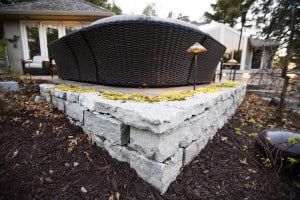05 Feb To mulch or not to mulch?
Each year our landscape crews focus on re-mulching beds during our annual spring cleanups. Mulch is necessary because it provides protection, nutrients, lengthens plant life and embellishes the look of your landscape. From weed control to happier plants, we recommend fresh mulch and here’s why…
Why mulch?
- Weed control-mulch acts as a natural barrier between the soil, weed seeds and sunlight.
- Happier plants-mulch lowers the surface temperature, reduces compaction, retains moisture, and increases organic material and oxygen in the soil as it decomposes naturally.
- Soil health-mulch retains moisture and increases naturally occurring nutrient levels and pH levels
- Erosion control-mulch holds in soil and helps prevent wash out from ground water.
- It looks great!
- It smells nice! 🙂
Where to mulch?
- Mulch around all landscape beds and define with a good edge, the look of a natural edge is very eye appealing.
- Mulch around all trees, shrubs and flowers planted in the yard to protect them from lawn mowing equipment and provide adequate room to grow and thrive.
- Mulch inside of your flower and vegetable gardens to control weeds and prevent erosion.
When to mulch?
- We recommend mulching every spring. Ideally, this is done before all perennials begin to emerge for easier and more thorough installation. It is also helpful to apply mulch in the spring before the heavy rains and heat arrive later in the summer.
- The next best time to mulch is in the late fall. The only downside of this is that the color may fade before the next growing season.
- You can mulch anytime during the season to top dress or when you install new plantings.
Mulch tips:
- Buy high quality, double shredded mulch from local suppliers. Locally produced mulch comes from local trees. These native trees will decompose properly in our environment and will provide the proper nutrients and soil pH. Buying locally produced mulch also reduces the risk of spreading unwanted diseases from other parts of the country. (Sun Valley’s mulch is produced from 100% native Midwestern trees).
- Inspect dyed mulch to be sure it is dry upon purchase so that the dye does not bleed. The best practice is to have a curing period for dyed mulch allowing it to fully soak in and stay put.
- Un-dyed or natural mulch, such as cedar, may break down more quickly vs. dyed mulch, however, properly dyed mulch is perfectly safe for pets and children and will break down into the soil providing all the same benefits as normal mulch. (Sun Valley uses only naturally occurring dyes for its mulch.)
- Maintain a mulch depth of 2”-4” at all times. You may need to remove old mulch if there is excess in your beds. More mulch is not better.
- Before mulching is it recommended to clean out your beds and perform any remaining pruning of perennials, shrubs and grasses.
- Make your mulch pop with a freshly cut natural edge! Natural edges are easily maintained and keep a nice separation from grass and mulch beds.
- BEFORE you mulch, we recommend applying a granular pre-emergent, such as Preen or Snapshot, to act as an additional barrier to weed growth in the spring. We also encourage a balance spring garden fertilizer to be applied at this time. Applying pre-emergent fertilizer before the mulch allows the product to reach the soil more easily.
- DO NOT place landscape fabric below mulch. Placing fabric below the mulch will not allow for many of the great mulch benefits to occur – soil health, weed control, erosion control etc. After a few seasons, you will end up with a compost layer of decomposed mulch sitting on top of a piece of fabric (a perfect recipe for weed growth) not delivering the organic material to the soil and to your plants where it’s really needed.
Stay tuned for an upcoming blog post that will identify additional ground cover options, such as rock, and the pros and cons compared to mulch coverage for your soil and overall plant health.



